Using ClearContext IMS Pro with GTD: Review
Our last post detailed Project Designation using ClearContext IMS Pro with Getting Things Done. Our next excerpt from the setup guide Using ClearContext IMS Professional for Microsoft Outlook with Getting Things Done is on Review.
Review
Once the Inbox has been processed, IMS provides several methods for reviewing and acting on To-Do Lists.
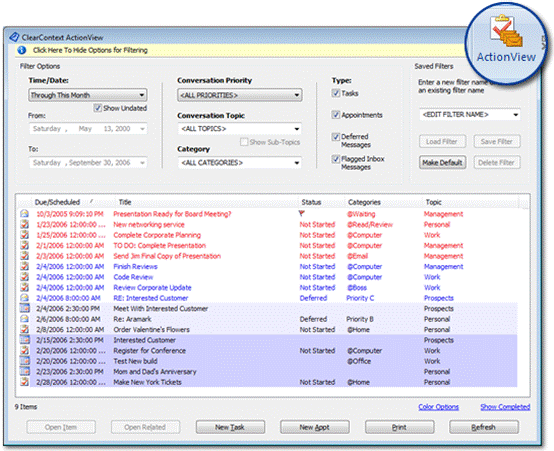
To view action items, select the ActionView button on the ClearContext toolbar and filter the results by category. This is your Action List – it shows all open tasks and appointments for the given context. Further refine the results by filtering by priority, topic, or date range. Show/hide filtering options by clicking the yellow information bar at the top of the ActionView.
Create pre-defined filters for lists that you review periodically. For example, to create a filter to show all of the tasks you need to perform when you are ready to work at your computer:
- Open the ActionView and press the yellow information bar to open filtering options.
- Select the category @Computer from the drop down in the middle of the options.
- Under saved filters, type a filter name in the drop down (where it initially says <DEFAULT> or <LOAD FILTER>).
- Click Save Filter.
The next time you are at your computer, select the newly created filter from the drop down and click Load Filter to open all of your To-Do’s assigned a category of @Computer.
Weekly Review
Many GTD users find David Allen’s suggestion of a weekly review to be the most critical component of their GTD implementation. To automate the weekly review with ClearContext IMS, use the ActionView and ClearContext’s custom Inbox views to process actions by project. To perform the review, use these tools on a weekly basis:
- Select the ClearContext Prioritized By Week view (ClearContext > Inbox Views > Prioritized by Week), go through the email remaining for the last week and action it using Task, Schedule, Delegate, Defer or Delete.
- Select the ActionView button on the ClearContext toolbar. This creates a list of all Tasks, Appointments, and Deferred messages in the mail file.
- Use Filter By Date to review the last week’s tasks and appointments and take action or mark complete as appropriate. Optionally filter by category (action), topic (project), or priority.
- Change the filter to review future tasks, appointments, and deferred messages. Capture any new actions that come to mind using the buttons at the bottom of the ActionView dialog.
- If filtering by category or project, repeat for each item on these lists.
- Review the Someday/Maybe folder and transfer any items to your system that have become active or delete any items that are no longer relevant.
RelatedView
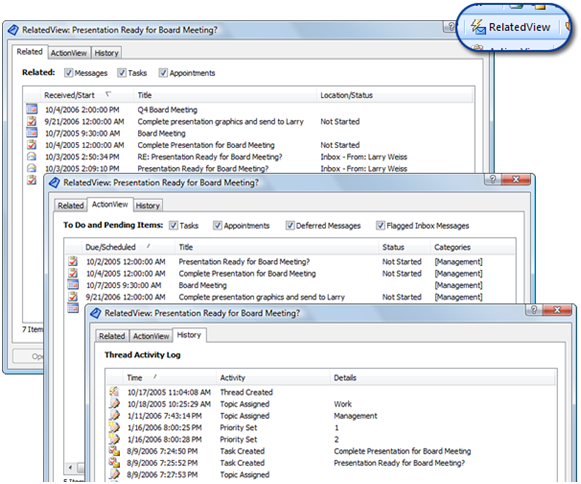
The RelatedView is a view of all related items for a given conversation. For example, your Inbox is empty and you receive a new message regarding a meeting you are attending later in the week. Click the RelatedView to see previous emails about this meeting, along with any tasks or appointments created from the conversation. In Outlook 2007, the RelatedView is integrated into all messages, tasks and appointments.
For Advanced Outlook Users: Creating Custom Task Views that Include the Topic Name
The ActionView is the quickest way to view all To Do items, including Tasks and Appointments, by Topic name. If desired, the Topic name can be added to custom task views so that tasks within the native Outlook task pane can be sorted by project as well. To add Topic to a Task view:
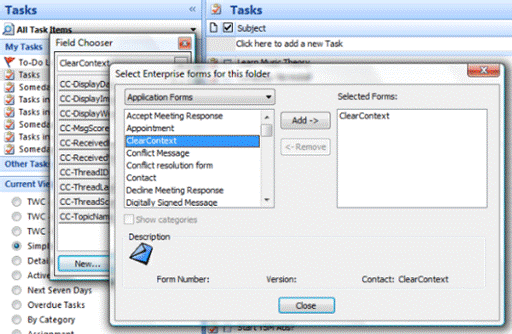
- Go to the task pane and click on the view that you want to alter.
- Right click the header on the tasks list (i.e. where it says Subject, Due Date, etc.) and select "Field Chooser."
- Select "Form…" in the drop down where it says "Frequently Used Fields:"
- In the "Select Enterprise forms for this folder" dialog select Application Forms.
- Highlight ClearContext and press Add…
- Close the current dialog.
- In the Field chooser, add CC-TopicName by clicking it and dragging it to the headers you initially right clicked.
- Exit out of the field chooser.
- If desired, change the name of the header on this field by right clicking CC-TopicName, selecting Format Columns, and changing the Label.
- Repeat for each view that you want to alter.
[Our last post in the GTD series will be on Prioritization. Download the entire guide here.]
GTD and Getting Things Done are registered trademarks of David Allen & Company. ClearContext Corporation is not affiliated with David Allen & Company in any manner.

 File Msg, Thread and Topic buttons quickly move email messages with assigned topics from the Inbox to automatically created Topic folders for later reference. In addition, IMS can automatically save sent messages in these topic folders to ensure that all project correspondence is properly tagged and stored together in one filing system. Topic assignments are automatically carried over to Tasks and Appointments generated from email conversation and Topics can be easily assigned to new items as they are created.
File Msg, Thread and Topic buttons quickly move email messages with assigned topics from the Inbox to automatically created Topic folders for later reference. In addition, IMS can automatically save sent messages in these topic folders to ensure that all project correspondence is properly tagged and stored together in one filing system. Topic assignments are automatically carried over to Tasks and Appointments generated from email conversation and Topics can be easily assigned to new items as they are created.  Topic Selector can be used to quickly assign Topics. Press the Topic button to the left of the Topic drop down to pull up the Topic Selector window. Start typing the Topic name and IMS will narrow the Topic list to match your search. Arrow down to select a Topic and assign to the conversation. This dialog is particularly useful for those who have a long list of projects. The Topic Selector is also launched when a file button is pressed on a message that does not have a Topic assigned.
Topic Selector can be used to quickly assign Topics. Press the Topic button to the left of the Topic drop down to pull up the Topic Selector window. Start typing the Topic name and IMS will narrow the Topic list to match your search. Arrow down to select a Topic and assign to the conversation. This dialog is particularly useful for those who have a long list of projects. The Topic Selector is also launched when a file button is pressed on a message that does not have a Topic assigned. 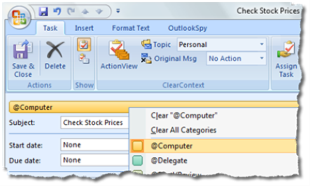
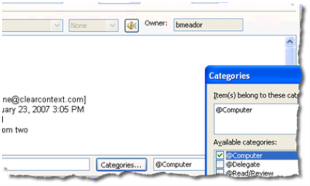
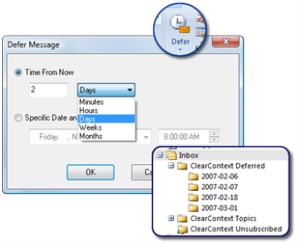 Many GTD’ers follow Mr. Allen’s suggestion of creating a “tickler file.” ClearContext’s Defer button is an excellent way to maintain an electronic version of this file. The Defer button moves an email out of the inbox and schedules it as unread at a given time interval or on a given date.
Many GTD’ers follow Mr. Allen’s suggestion of creating a “tickler file.” ClearContext’s Defer button is an excellent way to maintain an electronic version of this file. The Defer button moves an email out of the inbox and schedules it as unread at a given time interval or on a given date. 
 Categories = Context: Use ClearContext workflow buttons (Task, Schedule, Delegate, Defer, etc.) to quickly process messages in the Inbox. When creating a Task or Appointment, use Outlook native categories to denote context (@Work, @Phone, etc.) for easy viewing of context-specific action lists. ClearContext will automatically file messages to their Topic folder as Tasks and Appointments are created.
Categories = Context: Use ClearContext workflow buttons (Task, Schedule, Delegate, Defer, etc.) to quickly process messages in the Inbox. When creating a Task or Appointment, use Outlook native categories to denote context (@Work, @Phone, etc.) for easy viewing of context-specific action lists. ClearContext will automatically file messages to their Topic folder as Tasks and Appointments are created.  Review: Use the ActionView to review your To-Do’s by context, project and/or date. The ActionView displays all To-Dos’ – tasks, appointments, flagged items and deferred messages – and filters them by Topic or Category.
Review: Use the ActionView to review your To-Do’s by context, project and/or date. The ActionView displays all To-Dos’ – tasks, appointments, flagged items and deferred messages – and filters them by Topic or Category. 








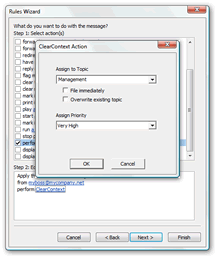 While we still think
While we still think 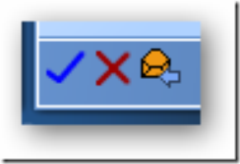 We’ve added three new action buttons to the Inbox Alert Windows Vista Sidebar Gadget. Now you can Mark Read, Delete or Reply to the message you are previewing (Outlook 2007 only). We haven’t posted to the Windows Live Gallery site yet,
We’ve added three new action buttons to the Inbox Alert Windows Vista Sidebar Gadget. Now you can Mark Read, Delete or Reply to the message you are previewing (Outlook 2007 only). We haven’t posted to the Windows Live Gallery site yet, 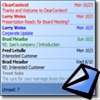
 The gadget is a great way to give yourself focus on the work at hand without missing really important messages. Turn all of your new mail notifications off and configure the gadget filter to show Very High priority messages only. Inbox Alert will only display your important messages and you can get to the less important ones when you have some free time. To turn off notifications in Outlook, go to Tools > Options > Preferences > E-Mail Options > Advanced E-mail Options and uncheck every item under “When new items arrive in my Inbox.” Honestly, you should do this even if you aren’t running the gadget. You can thank me later for the productivity gains!
The gadget is a great way to give yourself focus on the work at hand without missing really important messages. Turn all of your new mail notifications off and configure the gadget filter to show Very High priority messages only. Inbox Alert will only display your important messages and you can get to the less important ones when you have some free time. To turn off notifications in Outlook, go to Tools > Options > Preferences > E-Mail Options > Advanced E-mail Options and uncheck every item under “When new items arrive in my Inbox.” Honestly, you should do this even if you aren’t running the gadget. You can thank me later for the productivity gains!